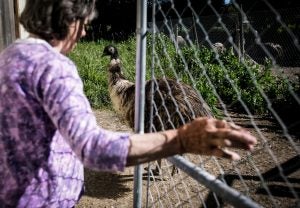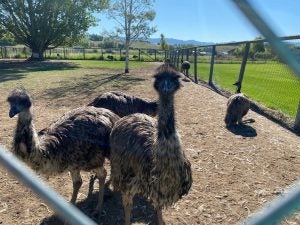An inside look at a niche U.S. market and who’s buying emu meat
Clover Quinn picked up a large emu feather from the dirt floor of an outdoor pen at the Wild Rose Emu Ranch in Hamilton, Montana.
“I love to gather emu feathers,” said Quinn. “They’re so unusual. Each emu quill has two long feathers growing from it instead of just one.”
These feathers — used by fly fishermen in Montana’s Bitterroot valley to tie homemade flies and by local florists to accent floral arrangements — are just one of many byproducts of emu farming. Quinn and her husband, Joe, have farmed these prehistoric-like tall flightless birds for more than two decades.
On average, the Quinns host 70 emus on their farm, including a few breeding pairs which are essential for reproduction. The birds, both male and female, live together in pastures with 6-foot-tall chain link fencing until they reach what Quinn calls the “teenage years” — which is about 13 to 14 months of age.
“That’s the best age for harvesting,” said Quinn.

The hands-on farm work takes Joe Quinn about 20 hours a week — filling self-feeders every other day, maintaining fencing and filling water troughs. Marketing and selling the emu meat and oil is where the time commitment is. Clover Quinn spends an average of 60 hours a week filling online orders, delivering meat to local grocery stores, and sitting at local farmers markets selling emu products.
“I’ve had so much fun over the years,” said Quinn, as the low drumming sound of an emu echoed in the distance. “I feel like I haven’t aged a day.”
For farmers such as Quinn, raising emus in the United States is the agricultural road less taken. Emu farmers are few in number compared with other agricultural industries. But the growing demand for new and unique sources of healthy meat like emu has helped keep emu farmers in business. Part of this demand is fueled by the U.S. spread of a tick-borne allergy to mammal meat (commonly referred to as the alpha-gal syndrome), and people with alpha gal who long for the taste, texture, and nutritional benefits of red meat are buying up this savory exotic meat option.

American emu farming
Emus are a flightless wild bird from Australia. For thousands of years, hunters harvested emus for their meat, oil, skin, and feathers. But emus didn’t arrive in large numbers in America until the 1930s and lived mostly in zoos. In the 1980s American emu farmers started raising emus from that original zoo stock, and by the 1990s, chefs coveted the tender meat and the media dubbed emu as “the nation’s next red meat.”
“Emu farming was booming back then,” said Terry Turner, president of the American Emu Association. “Everyone wanted into the business, and a breeding pair of emus could easily sell for $10,000 or more.”
But the emu boom was short lived. The supply for emu meat quickly caught up with demand. Then, exceeded it. Prices for emu breeding pairs dropped to about $1,000, and droves of emu farmers abandoned the industry. A Los Angeles Times article even dubbed the era, “The Craze That Didn’t Fly.”
Most of the farmers who stayed in the industry turned to commercial emu farming, but selling emu meat proved hard. One bird yields just 30 pounds of boneless meat (compared to a cow that can yield more than 500 pounds), and farmers had to find alternative ways to be profitable, like selling emu oil, eggs, organs, feathers, and hides. People have used emu oil on their skin for centuries to help fight dry skin and inflammation. And since each emu produces about two gallons of oil, it’s proven a profitable product. Emu organs are popular among dog food producers for their nutritional value. And fashion designers use emu hides to make exotic leather clothing.

Although emu farmers learned to be creative with marketing and sales, they also needed to educate the American people about the nutritional value of emu meat.
“Twenty-five years ago, I’d sit at my local farmer’s market in Colorado and hand out chili samples from a crock pot,” said Turner. “Sometimes it was spaghetti sauce on a baguette. Anything to get people to buy my emu meat.”
And it worked. Over the years, those chili samplers turned into loyal customers, some of whom still buy meat from Turner today.
Through emu farmers’ educational and marketing efforts over the years, more Americans are eating emu meat, and emu farming is starting to make a comeback.
According to the latest U.S. Census of Agriculture, which was conducted in 2017, there are approximately 1,500 emu farms and roughly 11,500 emus in the U.S. It’s an estimate Turner believes is low, but those are the only numbers available.
Exactly how much emu meat is consumed by Americans each year is unknown.
“You’re not going to find that data because it doesn’t exist,” said Roxanne Smith, director of congressional and public affairs with the U.S. Department of Agriculture.
Emus are amenable, meaning they are an exotic species subject to mandatory federal inspection under the Federal Meat Inspection Act if the meat is sold outside of state lines. The bottom line — emu meat is inspected nationally, but not recorded.
Ngon Nguyen, emu farmer and co-founder of Amaroo Hills farm in Tennessee, estimated that about 70,000 pounds of emu meat is sold in the U.S. annually, while beef, for example, accounts for about 25 billion pounds.
“We’re a blip comparatively,” said Nguyen.
Although there aren’t accurate records of emu meat sales in the U.S. by the pound, there remains a niche demand for it, and those with the alpha-gal syndrome are some of the industry’s most dedicated customers.

Alpha-gal syndrome and emu meat
If you’re bitten by a lone star tick, you could develop an allergy to mammal meat like beef, pork, and lamb.
“Back in 2003 I was mowing tall grass out on the farm” said Nguyen. “I looked down and saw ticks all over my legs. It was very itchy. I ran into the house and tried to wash them all off in the tub.”
After that, Nguyen couldn’t eat mammal meat without having an allergic reaction. Those reactions in people with alpha gal include anaphylaxis, itchy or painful rashes, headaches, and a overall sense of low energy.
By 2009, Nguyen’s meat allergy had a formal name — alpha-gal syndrome. A syndrome described by physicians at the Mayo Clinic as, “a food allergy to red meat and other products made from mammals.” According to the American Academy of Allergy Asthma and Immunology, alpha-gal is a molecule carried in the saliva of lone star ticks and other potential arthropods typically after feeding on mammalian blood. People bitten by the tick, especially those who are bitten repeatedly, are at risk of becoming sensitized and producing the antibodies necessary to then cause allergic reactions.
“I wanted to eat good food again, and chicken and turkey just doesn’t make a good burger,” said Nguyen. “Emu meat was the closest tasting to beef, and it has twice the iron and four times the vitamin B-12.”
But the market was particularly small at the time, and emu meat wasn’t easily available. That’s when Nguyen started farming emus at Amaroo Hills alongside ostriches and ducks — a passion that’s grown into a thriving business.
“Helping people eat normal again is a mission of ours,” added Nguyen. “I saw emu farming as a miracle solution for people with alpha gal.”

A demand for emu meat
For the last eight years, Nguyen has sold emu meat to restaurants, local health food stores, and direct to customers online — and demand continues to steadily increase.
“The emu burgers from Amaroo Hills are great,” said Tammi McGraw in Pittsboro, North Carolina, who was diagnosed with the alpha-gal syndrome in 2013.
“I had gotten pretty anemic no matter how many beans I ate,” said McGraw. “Once I included the emu in my diet, it got much better.”
In March and April 2020, due to COVID-19, state governments mandated that restaurant owners close their doors.
“Restaurants are a huge customer base for us,” said Nguyen. “And we temporarily lost all of those accounts.” But during the shutdown, Amaroo Hills’ online meat sales easily made up for it. Nguyen estimated a 25 percent to 30 percent increase in online sales during the two-month shutdown.
Clover Quinn, owner of the Wild Rose Emu Ranch, had a similar experience.
“Our meat sales have been good and have steadily increased over the years,” said Quinn. “I just took 100 pounds of emu meat to the Good Food store in Missoula.” Although Quinn’s restaurant sales were also temporarily cut off during the recent economic shutdown, Quinn said her direct-to-customer sales didn’t slow.
Quinn has out-of-state customers with alpha-gal that drive to her rural farm just to buy her meat.
“They bring their coolers here, and I fill them up with emu meat,” said Quinn, who’s meat is only inspected at the state level and not available for shipment across state lines.

Elsewhere, emu meat sales for Fossil Farm’s owners in Boonton, New Jersey, have steadily climbed over the past 23 years, and workers there say they’ve seen sales increase more than 150 percent from 2019 to 2020 alone.
“Now more than ever we’re seeing consumer and professional demand for sustainable alternatives increase,” said Dan Del Coro, director of national sales and marketing for Fossil Farms.
Del Coro said customers with alpha gal account for a good portion of emu meat sales and that the farm has dedicated an entire section of their website to those consumers.
For Don Collins, owner of the Montana Emu Ranch in western Montana, emu meat sales have also steadily increased over the past five years.
“One summer I sold more than 2,000 pounds of quarter-pound burgers to a chef in Glacier National Park,” said Collins.
“The demand is always there,” he said. “If I have emu meat, it’s going to sell.”
Collins hopes that other farmers and ranchers might consider getting into the emu market — one that’s proven lucrative for him and his staff.
“There aren’t enough producers to fill the current need,” added Collins.
As Clover Quinn held a bouquet of emu feathers in her hand, she echoed Collins’ statement.
“I’m retiring next year, and I’d like to see a young farming couple follow in my footsteps,” she said. “There’s an established emu market here in Montana and there’s a big opportunity for someone who’s willing to put in the hard work.”
What does emu meat cost?
Emu meat prices range by distributor, but here is an idea of what you can expect:
• $6 for 1 lb. of ground emu meat
• $7 for a 6-10 oz. emu flat filet
• $8 for a 12 oz. emu round steak
• $10 for a pack of 4 premium 5 oz. emu burger patties
• $12 for a 10-14 oz. emu fan filet
• $18 for a 28 oz. emu full rump
Suzanne Downing is an outdoor writer and photographer in Montana with an environmental science journalism background. Her work can be found in Outdoors Unlimited, Bugle Magazine, Missoulian, Byline Magazine, Communique, MTPR online, UM Native News, National Wildlife Federation campaigns and more.



